About the magnetic field, solenoids and electromagnets
Magnetic field of electric current
The magnetic field is not only created by natural or artificial permanent magnets, but also a conductor if an electric current passes through it. Therefore, there is a connection between magnetic and electrical phenomena.
It is not difficult to make sure that a magnetic field is formed around the wire through which the current flows. Place a straight wire over the movable magnetic needle parallel to it and pass an electric current through it. The arrow will take a position perpendicular to the wire.
What forces could cause the magnetic needle to rotate? Obviously, the strength of the magnetic field created around the wire. Turn off the power and the magnetic needle will return to its normal position. This suggests that when the current is turned off, the magnetic field of the wire also disappears.
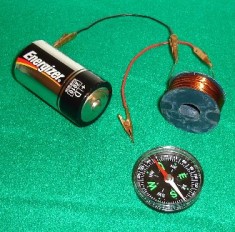
Thus, the electric current passing through the wire creates a magnetic field. To find out which direction the magnetic needle will deflect, apply the right-hand rule.If you place your right hand on the wire, palm down, so that the direction of the current coincides with the direction of the fingers, then the bent thumb will show the direction of deflection of the north pole of the magnetic needle placed under the wire. Using this rule and knowing the polarity of the arrow, you can also determine the direction of the current in the wire.
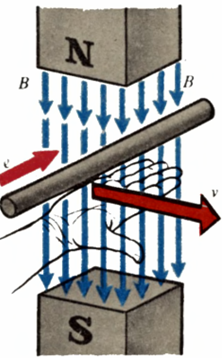
A rectilinear wire igneous field has the shape of concentric circles. If you place your right hand on the wire, palm down, so that the current flows from the fingers, then the bent thumb will point to the north pole of the magnetic needle. Such a field is called a circular magnetic field.
The direction of the lines of force of the circular field depends on directions of electric current in the conductor and is determined by the so-called gimbal rule. If the gimbal is mentally twisted in the direction of the current, then the direction of rotation of its handle will coincide with the direction of the magnetic field lines of the field. Applying this rule, you can find out the direction of the current in the wire if you know the direction of the field lines of the field created by that current.
Returning to the magnetic needle experiment, you can make sure that it is always positioned with its north end in the direction of the magnetic field lines.
Thus, a magnetic field arises around a straight wire through which an electric current passes. It has the shape of concentric circles and is called a circular magnetic field.
Soles etc. Solenoid magnetic field
A magnetic field arises around any wire, regardless of its shape, provided that an electric current flows through the wire.
V electrical engineering we deal with different types of coilsconsisting of a number of turns.To investigate the magnetic field of the coil of interest, let us first consider what shape the magnetic field of one turn has.
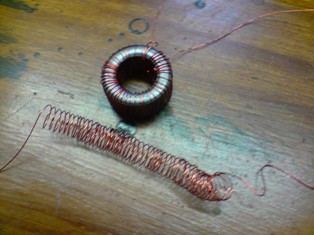
Imagine a coil of thick wire running through a piece of cardboard and connected to a power source. When an electric current passes through the coil, a circular magnetic field is formed around each individual part of the coil. According to the «gimbal» rule, it is easy to determine that the magnetic field lines inside the loop have the same direction (towards us or away from us, depending on the direction of the current in the loop) and they exit from one side of the loop and enter from the other side. A series of such coils, in the form of a spiral, is a so-called solenoid (coil).
A magnetic field is formed around the solenoid when current passes through it. It is obtained as a result of adding the magnetic fields of each turn and in shape resembles the magnetic field of a rectilinear magnet. The solenoid's magnetic field lines, as with a rectilinear magnet, leave one end of the solenoid and return to the other. Inside the solenoid they have the same direction. Thus, the ends of the solenoid are polarized. The end from which the power lines exit is the solenoid's North Pole, and the end where the power lines enter is its South Pole.
Solenoid poles can be determined by the right-hand rule, but for this you need to know the direction of the current in its turns. If you place your right hand on the solenoid, palm down, so that the current flows from the fingers, then the bent thumb will point to the north pole of the solenoid... From this rule it follows that the polarity of the solenoid depends on the direction of the current in it.This is easy to check in practice by bringing a magnetic needle to one of the solenoid poles and then changing the direction of the current in the solenoid. The arrow will immediately rotate 180 °, that is, it will show that the poles of the solenoid have changed.
The solenoid has the ability to draw the lungs. duseful objects. If a steel rod is placed inside the solenoid, after some time, under the influence of the magnetic field of the solenoid, the rod will be magnetized. This method is used in production permanent magnets.
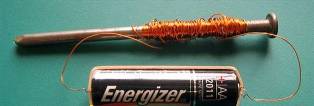
Electromagnets
Electromagnet is a coil (solenoid) with an iron core placed inside it. The shapes and sizes of electromagnets are different, but the general structure of all of them is the same.
The coil of an electromagnet is a frame made most often of pressboard or fiber and has different shapes depending on the purpose of the electromagnet. A copper-insulated wire is wound on the frame in several layers - the coil of the electromagnet. It has a different number of turns and is made of wire of different diameters, depending on the purpose of the electromagnet.
To protect the coil insulation from mechanical damage, the coil is covered with one or more layers of paper or other insulating material. The beginning and end of the winding are brought out and connected to the output terminals fixed on the frame or to flexible wires with ears at the ends.
 The coil of the electromagnet is mounted on a core made of soft, annealed iron or alloys of iron with silicon, nickel, etc. This iron has the least residue magnetism... The cores are most often made of thin sheets, insulated from each other.The shapes of the core can be different, depending on the purpose of the electromagnet.
The coil of the electromagnet is mounted on a core made of soft, annealed iron or alloys of iron with silicon, nickel, etc. This iron has the least residue magnetism... The cores are most often made of thin sheets, insulated from each other.The shapes of the core can be different, depending on the purpose of the electromagnet.
If an electric current passes through the coil of an electromagnet, then a magnetic field is formed around the coil, which magnetizes the core. Since the core is made of soft iron, it will be magnetized immediately. If you then turn off the current, the magnetic properties of the core will also quickly disappear and it will cease to be a magnet. The poles of an electromagnet, like a solenoid, are determined by the right-hand rule. If in the coil of the electromagnet andgmEat current direction, then the polarity of the electromagnet will change accordingly.
The action of an electromagnet is similar to that of a permanent magnet. However, there is a big difference between the two. A permanent magnet is always magnetic, and an electromagnet - only when an electric current passes through its coil.
In addition, the attraction force of the permanent magnet is unchanged, since the magnetic flux of a permanent magnet is unchanged. The force of attraction of an electromagnet is not constant. The same electromagnet can have different gravity. The force of attraction of any magnet depends on the magnitude of its magnetic flux.
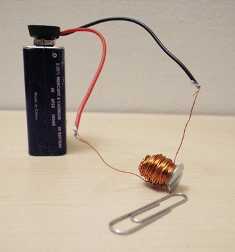
The attraction of a silt electromagnet, and therefore its magnetic flux, depends on the magnitude of the current passing through the coil of this electromagnet. The greater the current, the greater the force of attraction of the electromagnet and, conversely, the smaller the current in the coil of the electromagnet, the less force it attracts magnetic bodies to itself.
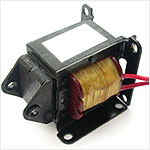 But for electromagnets of different design and size, the strength of their attraction depends not only on the magnitude of the current in the coil.If, for example, we take two electromagnets of the same device and size, but one with a small number of coils, and the other with a much larger number, then it is easy to see that at the same current the force of attraction of the latter will be much greater. Indeed, the greater the number of coils, the greater, at a given current, the magnetic field created around that coil, since it consists of the magnetic fields of each turn. This means that the magnetic flux of the electromagnet and, accordingly, the force of its attraction will be greater, the greater the number of turns of the coil.
But for electromagnets of different design and size, the strength of their attraction depends not only on the magnitude of the current in the coil.If, for example, we take two electromagnets of the same device and size, but one with a small number of coils, and the other with a much larger number, then it is easy to see that at the same current the force of attraction of the latter will be much greater. Indeed, the greater the number of coils, the greater, at a given current, the magnetic field created around that coil, since it consists of the magnetic fields of each turn. This means that the magnetic flux of the electromagnet and, accordingly, the force of its attraction will be greater, the greater the number of turns of the coil.
There is another reason that affects the magnitude of the magnetic flux of an electromagnet. This is the quality of its magnetic circuit. A magnetic circuit is the path along which the magnetic flux closes. The magnetic circuit has a certain magnetic resistance... The magnetic resistance depends on the magnetic permeability of the medium through which the magnetic flux passes. The greater the magnetic permeability of this medium, the lower its magnetic resistance.
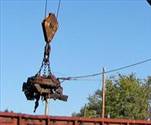 Since mmagnetic permeability of ferromagnetic bodies (iron, steel) is many times greater than the magnetic permeability of air, therefore it is more profitable to make electromagnets so that their magnetic circuit does not contain air sections. The product of the strength of the current and the number of turns of the coil of the electromagnet is called the magnetomotive force... The magnetomotive force is measured by the number of ampere-turns.
Since mmagnetic permeability of ferromagnetic bodies (iron, steel) is many times greater than the magnetic permeability of air, therefore it is more profitable to make electromagnets so that their magnetic circuit does not contain air sections. The product of the strength of the current and the number of turns of the coil of the electromagnet is called the magnetomotive force... The magnetomotive force is measured by the number of ampere-turns.
For example, a current of 50 mA flows through the coil of an electromagnet with 1200 turns. Magnetomotive force of such an electromagnet equal to 0.05 NS 1200 = 60 amperes.
The action of the magnetomotive force is similar to the action of the electromotive force in an electric circuit. Just as EMF is the cause of electric current, magnetomotive force creates magnetic flux in an electromagnet. Just as in an electric circuit, as the EMF increases, the value of the current increases, so in a magnetic circuit, as the magnetomotive force increases, the magnetic flux increases.
Magnetic resistance action similar to the action of electrical circuit resistance. Just as when the resistance of an electric circuit increases, the current decreases, so in a magnetic circuit, an increase in the magnetic resistance causes a decrease in the magnetic flux.
The dependence of the magnetic flux of an electromagnet on the magnetomotive force and its magnetic resistance can be expressed by a formula similar to the formula of Ohm's law: magnetomotive force = (magnetic flux / reluctance)
The magnetic flux is equal to the magnetomotive force divided by the reluctance.
The number of turns of the coil and the magnetic resistance for each electromagnet is a constant value. Therefore, the magnetic flux of a given electromagnet changes only with a change in the current flowing through the coil. Since the force of attraction of an electromagnet is determined by its magnetic flux, to increase (or decrease) the force of attraction of an electromagnet, it is necessary to increase (or decrease) the current in its coil accordingly.
Polarized electromagnet
A polarized electromagnet is the coupling of a permanent magnet to an electromagnet. It is arranged in this way. The so-called extensions of the soft iron poles are attached to the poles of the permanent magnet.Each pole serves as an electromagnetic core. A coil with a coil is placed on it. Both coils are connected in series.
Since the pole extensions are directly connected to the poles of a permanent magnet, they have magnetic properties even in the absence of current in the coils; at the same time, their force of attraction is unchanged and is determined by the magnetic flux of a permanent magnet.
The action of a polarized electromagnet is that as current flows through its coils, the force of attraction of its poles increases or decreases depending on the magnitude and direction of the current in the coils. This property of a polarized electromagnet is based on the action electromagnetic polarized relay and other electrical devices.
The action of a magnetic field on a current-carrying conductor
If a wire is placed in a magnetic field so that it is perpendicular to the field lines, and an electric current passes through that wire, the wire will begin to move and be pushed by the magnetic field.
As a result of the interaction of the magnetic field with the electric current, the conductor begins to move, that is, the electrical energy is converted into mechanical energy.
The force with which the wire is repelled by the magnetic field depends on the magnitude of the magnet's magnetic flux, the current in the wire, and the length of that portion of the wire that the lines of force cross. The direction of action of this force, i.e. the direction of movement of the conductor, depends on the direction of the current in the conductor and is determined by the left-hand rule.
If you hold the palm of your left hand so that the lines of the magnetic field enter it, and the extended four fingers are turned in the direction of the current in the conductor, then the bent thumb will indicate the direction of movement of the conductor... In applying this rule, you must remember that the field lines extend from the north pole of the magnet.
